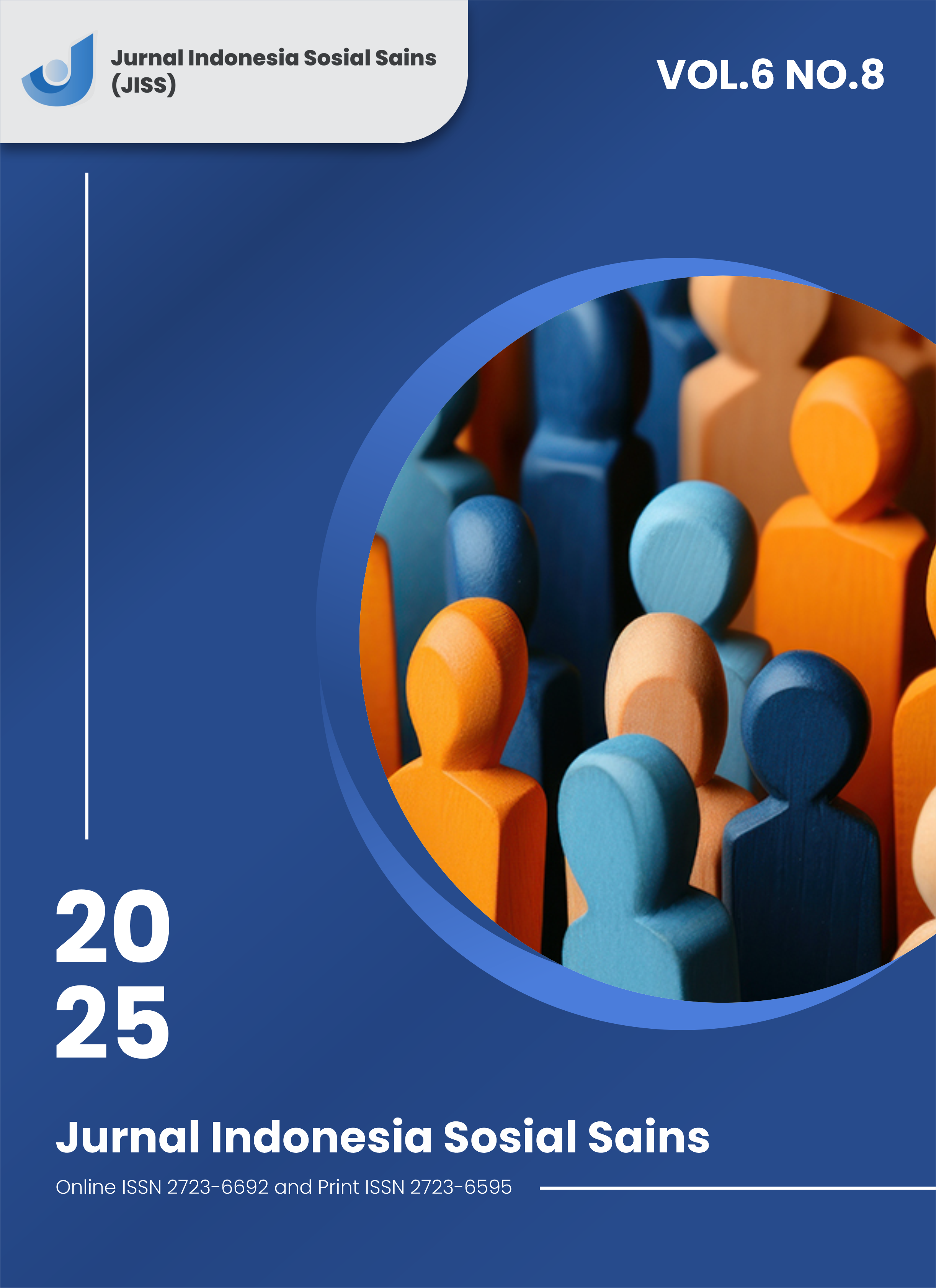Characteristics of Infarct and Hemorrhagic Stroke Patients Who Died at RSUD Bayu Asih Purwakarta, January–December 2024
DOI:
https://doi.org/10.59141/jiss.v6i8.1802Keywords:
Hemorrhagic, Infarction, Mortality, NIHSS, StrokeAbstract
Stroke is the leading cause of death globally, including in Indonesia, with two main types, namely infarctive stroke and hemorrhagic stroke. This research aims to determine the risk factors for stroke, infarction, and hemorrhagic patients who die at Bayu Asih Purwakarta Hospital. This research was an observational analytical study with a cross-sectional retrospective design using medical record data of stroke patients who died during the period January–December 2024. Data were analyzed univariately using Microsoft Excel and SPSS v30.1. Results: Of the 227 stroke patients who died, 117 (51.5%) had infarctive stroke and 110 (48.5%) had hemorrhagic stroke. The age of >66 years dominates infarction deaths, while the age of 46–55 years is most commonly found in hemorrhagic strokes. Women die more from both types of stroke. Stage 2 hypertension dominates infarctive stroke, while hypertension crisis is most common in hemorrhagic stroke. The majority of heart attack patients have a history of diabetes mellitus, while hemorrhagic strokes are more common without a history of DM. NIHSS scores indicate that most patients have very severe neurological deficits. Conclusion: Most of the deaths due to stroke at Bayu Asih Purwakarta Hospital most occur in elderly patients, especially in infarct stroke cases. While hemorrhagic strokes are more common at younger ages with very high blood pressure and higher NIHSS scores. The female gender also shows a higher mortality trend, in line with national findings. These factors can be used to prioritize early management and secondary prevention of stroke, especially in high-risk groups.
References
Arifin, M., Setyawati, T., & Wahyuni, S. (2023). Implementasi NIHSS sebagai prediktor luaran klinis pasien stroke akut di rumah sakit tingkat sekunder. Jurnal Neurologi Indonesia, 9(1), 10–17.
Gall, S. L., Reeves, M. J., Rist, P. M., et al. (2019). Sex differences in mortality following stroke: the reasons for geographic and racial differences in stroke study. Stroke, 50(2), 307-314. https://doi.org/10.1161/STROKEAHA.118.021031
Huo, Y., et al. (2020). Diabetes and risk of stroke: a prospective cohort study in China. BMJ Open Diabetes Research & Care, 8(1), e001001. https://doi.org/10.1136/bmjdrc-2019-001001
Kharbuja, R., Bhandari, M., Timalsina, S., et al. (2022). Predictive value of NIH Stroke Scale on the outcome of acute stroke patients: A prospective observational study. BMC Neurology, 22(1), 291.
Lestari, P., Wulandari, R., & Andriani, D. (2023). Perbedaan luaran klinis pasien stroke berdasarkan jenis kelamin di rumah sakit rujukan. Jurnal Keperawatan Medik, 12(1), 33–38.
Lestari, Y., & Permana, R. (2022). Management of hemorrhagic stroke: A retrospective analysis of treatment outcomes in Indonesia. Indonesian Journal of Stroke, 11(3), 90-97.
O'Donnell, M. J., et al. (2016). Risk factors for ischaemic and intracerebral haemorrhagic stroke in 22 countries: the INTERSTROKE study. Lancet, 388(10046), 761–775. https://doi.org/10.1016/S0140-6736(16)30506-2
Prabowo, N., Suryanto, A., & Adisasmita, A. (2021). A comprehensive review of ischemic stroke management in Indonesia: Challenges and opportunities. Acta Neurologica Indonesiana, 8(1), 5-12.
Putra, A., Santoso, S., & Sutanto, R. (2022). The outcome of hemorrhagic stroke in a tertiary hospital in Indonesia: A retrospective cohort study. Journal of the Neurological Sciences, 428, 117548.
Ramadhan, F., Dewi, P. R., & Yuliani, N. (2022). Profil pasien stroke di RSUPN Dr. Cipto Mangunkusumo: Perbandingan stroke iskemik dan hemoragik. Jurnal Neurologi Klinik Indonesia, 10(1), 18–24.
Saputro, D. R., Nurrahmat, M. H., & Lestari, D. S. (2022). Distribusi usia pada pasien stroke iskemik dan hemoragik di rumah sakit pendidikan. Jurnal Keperawatan dan Kesehatan Masyarakat, 11(3), 210–216.
Sari, D., Wulandari, E., Rahmawati, L., et al. (2023). Factors influencing mortality in ischemic stroke patients in Indonesia: A hospital-based study. Indonesian Journal of Neurology, 11(2), 65-73.
Sato, S., Toyoda, K., Uehara, T., et al. (2019). Baseline NIH Stroke Scale Score predicting outcome after acute ischemic stroke. Stroke, 50(3), 707-713. https://doi.org/10.1161/StrokeahA.118.023858
Setiawan, B., Prasetyo, A., & Wirawan, S. (2023). Mortality and functional outcome of stroke patients in a regional hospital: A 3-year retrospective cohort study. Indonesian Medical Journal, 17(4), 233-240.
Sheth, K. N., et al. (2021). Blood pressure management in acute stroke. Stroke, 52(2), e110–e118. https://doi.org/10.1161/STROKEAHA.120.032947
Tolefac, P. N., Halle, M. P., Kuate Tegueu, C., et al. (2020). Stroke mortality and its determinants in a resource-limited setting: a prospective cohort study in Cameroon. BMJ Neurology Open, 2(1), e000032. https://doi.org/10.1136/bmjno-2019-000032
World Health Organization. (2020). Global Health Estimates 2020: Deaths by cause, age, sex, by country and by region, 2000–2019. WHO.
Yulita, D., Susanto, E., & Rahayu, D. (2023). Karakteristik pasien stroke iskemik dan hemoragik di RSUD Dr. Moewardi. Jurnal Kesehatan Surakarta, 8(2), 101–108.
Downloads
Published
How to Cite
Issue
Section
License
Copyright (c) 2025 Ahmad Zakki Komarudin, Taufan Putra Widodo, Murti Astuti, Zuhaira Syam, Ganda Septianda Hedwar

This work is licensed under a Creative Commons Attribution-ShareAlike 4.0 International License.
Authors who publish with this journal agree to the following terms:
- Authors retain copyright and grant the journal right of first publication with the work simultaneously licensed under a Creative Commons Attribution-ShareAlike 4.0 International. that allows others to share the work with an acknowledgement of the work's authorship and initial publication in this journal.
- Authors are able to enter into separate, additional contractual arrangements for the non-exclusive distribution of the journal's published version of the work (e.g., post it to an institutional repository or publish it in a book), with an acknowledgement of its initial publication in this journal.
- Authors are permitted and encouraged to post their work online (e.g., in institutional repositories or on their website) prior to and during the submission process, as it can lead to productive exchanges, as well as earlier and greater citation of published work.












